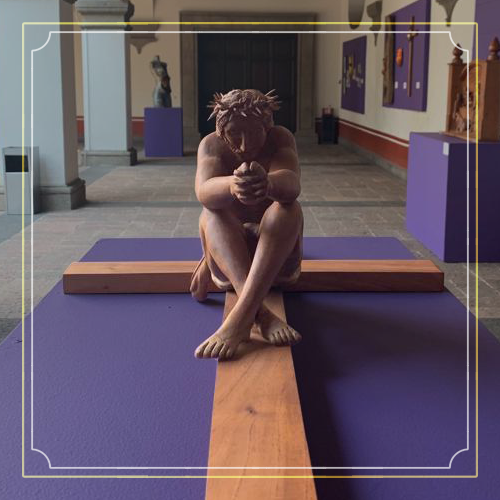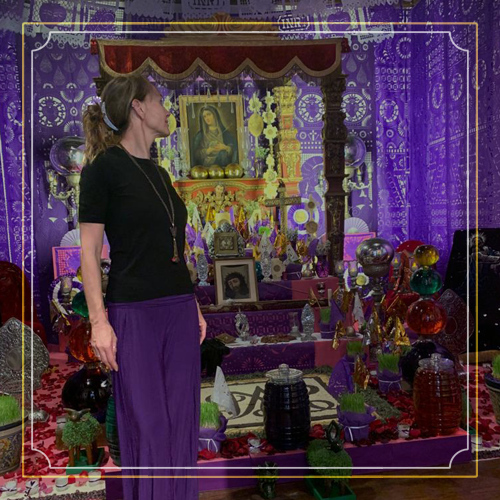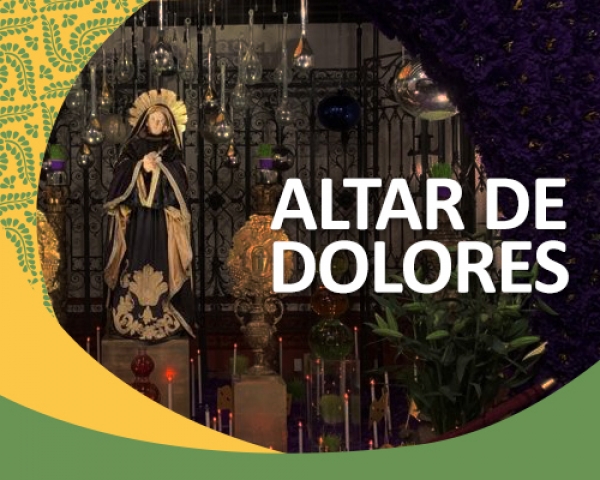
Blog
Altar de Dolores
Throughout Mexico, in every corner of the country from the northern deserts to the jungle-lined Caribbean coast, the last Friday of each Lent is observed with a day of commemoration and empathy for the Seven Sorrows of the Virgen María (Virgin Mary). Known as viernes de Dolores (Friday of Sorrows), the day is marked with special altars in churches, cathedrals, homes, shops, and public spaces.
These Altares de Dolores are some of Catholic Mexico’s most ornate; they are a physical display of the deep affection and high esteem in which the faithful hold the Virgen María. Whether these physical representations of love and devotion are in places of honor within the home, at the heart of a church, in the streets or in pride of place in a tienda (a local grocery store) or café, they always stand apart from altars created at other times of the year.
What does an Altar Virgen de Dolores look like?
An Altar de Dolores in Mexico is generally purple in color, with swathes of crepe or a luscious fabric used to cover the altar’s platform. Atop this, symbolic plants and candles are placed, amongst the world-famed Mexican floral pattern arrangements. Depending on the size and location of an altar, the floral arrangements in particular can be vast – taking up, for example, several feet of church floor around the altar space – while a household altar may be contained to a small side-table.


Iconic artefacts are placed among the flowers and plants, differing from altar to altar, region to region, and family to family. These items can be extremely personal to the altar’s maker or can have a particular significance to one or more of Our Lady’s Sorrows. Intricately patterned silver items are often favored, which, when set against the rich purple, give an air of regal beauty to the altar. Colors symbolism is extremely important, with purple representing grief, white symbolizing purity, and red signifying Jesus’ blood.
Fruits are often placed in amongst the decorations and, this being the plentiful Mexico, our local fruits are wonderfully exotic – grapes, pineapples, and bitter oranges (denoting the bitterness of Mary’s grief) can often be seen on Altares a la Virgen de Dolores.
Of course, the centrepiece of any Altar de Dolores is an image of the Virgen María. Often a statue, sometimes a painting, La Virgen de los Dolores (The Virgin of Sorrows) is depicted weeping while wearing a heartbreakingly lamenting expression. She is frequently depicted wearing purple or mourning black. Small bottles of colored water are often placed near her, to represent her tears.
Los Siete Dolores de María (The Seven Sorrows of Mary) are graphically symbolized as swords piercing The Virgin’s heart; three from one side and four from the other.

Los Siete Dolores de María
Each sword symbolizes a specific one of Our Lady’s Sorrows:
- Simeon’s prophecy at the Temple; When her son was only 40 days old, Mary was told how he would die, and that she would feel as if her soul would be pierced by a dagger.
- Fleeing to Egypt; An angel guided Mary, Joseph and baby Jesus into Egypt, to escape King Herod’s wrath.
- The loss of Jesus in the temple; Jesus disappeared for three days when The Holy Family visited the Temple. He had been speaking with the priests and elders, but Our Lady was unable to find him for these three days.
- Jesus and his Mother meet on the Way of the Cross; With no choice but merely to watch as her son carried his cross to his execution site, Mary witnessed his face covered in blood from the thorns of his crown and his body so weak that he stumbled under the weight of the cross.
- The crucifixion; Mary watched as her son was crucified.
- Jesus’ body is removed from the cross; Our Lady received the dead body of her son after he was removed from the cross.
- Jesus’ burial; Jesus was buried in a borrowed grave, with the preparation of the grave and His body performed by Mary and other women, as was tradition.
What happens on viernes de Dolores?

Beginning around 800 years ago, the tradition of observing Our Lady’s seven sorrows was most likely started by Franciscan monks in Europe, with the day of observance set as the sixth Friday of Lent in Germany in the 1400s.
As the last Friday of the Lenten season, there is of course no feasting on Viernes de Dolores. However, many Mexican communities still keep alive the quaint traditions of eating and gifting sherbet (called nieve, which means ‘snow’), and of making and gifting to passers-by a cooling drink made from fresh fruit and cinnamon. Holy masses are attended and special prayers dedicated to Nuestra Señora de los Dolores.
There are some areas of Mexico that mark Viernes de Dolores more dramatically than others (Oaxaca is known for its prolific and striking incedios, or altars, in public spaces at this time of year, for instance) but the symbolism and dedication is equal throughout our beautiful country.
To find out more about this deeply important time of year in Catholic Mexico, read about Semana Santa here.

